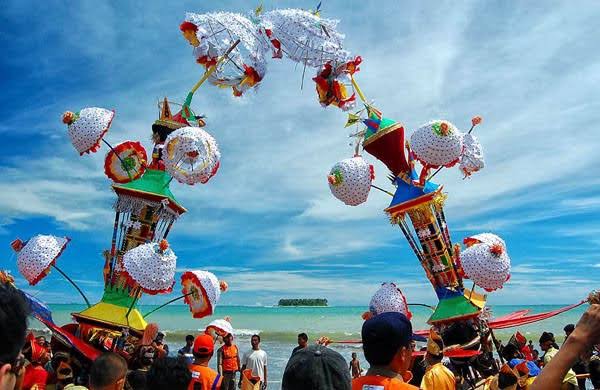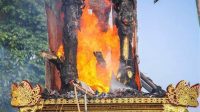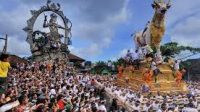KUPASONLINE.COM — The Tabuik Festival is one of the annual traditions in the Pariaman community. This festival has been going on for decades and is thought to have existed since the 19th century AD.
The tabuik event is part of the commemoration of the death of the Prophet Muhammad’s grandson, Hussein bin Ali, which falls on the 10th of Muharram. History records that Hussein and his family died in the war in the Karbala desert.
Tabuik itself is taken from the Arabic word ‘ark’ which means wooden crate. The name refers to a legend about the appearance of a creature in the form of a winged horse and a human head called the buraq. The legend tells that after the death of the Prophet’s grandson, a wooden box containing the pieces of Hussein’s body was flown into the sky by a buraq.
Based on this legend, every year the people of Pariaman make an imitation of the buraq that is carrying the ark on its back.
According to stories that have been passed down from generation to generation, this ritual is thought to have appeared in Pariaman around 1826-1828 AD. Tabuik at that time was still strong with influences from the Middle East brought by people of Indian descent who adhered to Shia. In 1910, an agreement emerged between the villages to adapt the Tabuik celebration to Minangkabau customs, so that it developed into what it is today.
Tabuik consists of two kinds, namely Tabuik Pasa and Tabuik Subarang. Both come from two different areas in Kota Pariaman. Tabuik Pasa (market) is an area on the south side of the river that divides the city to the shores of Gandoriah Beach. The Pasa region is considered the origin of the tabuik tradition. The Subarang tabuik originates from the Subarang area (across), namely the area on the north side of the river or an area known as Kampung Jawa.
Initially, there was only one tabuik, namely tabuik pasa. Around 1915, at the request of a group of people, another tabuik was made. Based on the agreement of the nagari elders, this tabuik must be made in the area across the Pariaman River.
Therefore, this second tabuik is named Tabuik Subarang. One history of the community elders recorded that the incident was estimated to have occurred in 1916, but there is also a history that mentions 1930. The making of the tabuik subarang still followed the procedures that had previously been in effect in the Pasa area.
Starting in 1982, the tabuik celebration was made part of the Padang Pariaman Regency tourism calendar. Because of this, various adjustments took place, one of which was in terms of the timing of the peak event of this series of tabuik rituals. So, even though the initial tabuik ritual procession still starts on the 1st of Muharram, during the celebration of the Islamic New Year, the implementation of the peak event varies from year to year, it no longer has to be on the 10th of Muharram.
The series of tabuik traditions in Pariaman consists of seven stages of the tabuik ritual, namely taking soil, cutting down banana stems, mataam, parading the fingers, parading the turban, tabuik riding the pangkek, hoyak tabuik, and throwing the tabuik into the sea.
The procession of taking land is carried out on 1 Muharram. Cutting banana stems is carried out on the 5th day of Muharram. Mataam on the 7th day, followed by mangarak the fingers at night. On the following day, the mangarak saroban ritual was held.
On the peak day, the tabuik ritual rises to the pangkek, followed by the hoyak tabuik. This peak day used to fall on the 10th of Muharram, but now every year it varies between 10-15 Muharram, usually adjusted for weekends. As a closing ritual, before maghrib the tabuik is paraded to the beach and floated into the sea.
Every year the peak of the tabuik event is always witnessed by tens of thousands of visitors who come from various parts of West Sumatra. Not only local people, this festival also gets the attention of many foreign tourists which makes it a big event that people look forward to every year.
Gandoriah Beach, which is the center of attention, seems to be a sea of people, especially before the Tabuik procession is paraded to the beach. Therefore, if there is an opportunity, there is nothing wrong if this tabuik festival becomes an alternative to your tourism agenda in the coming year.







